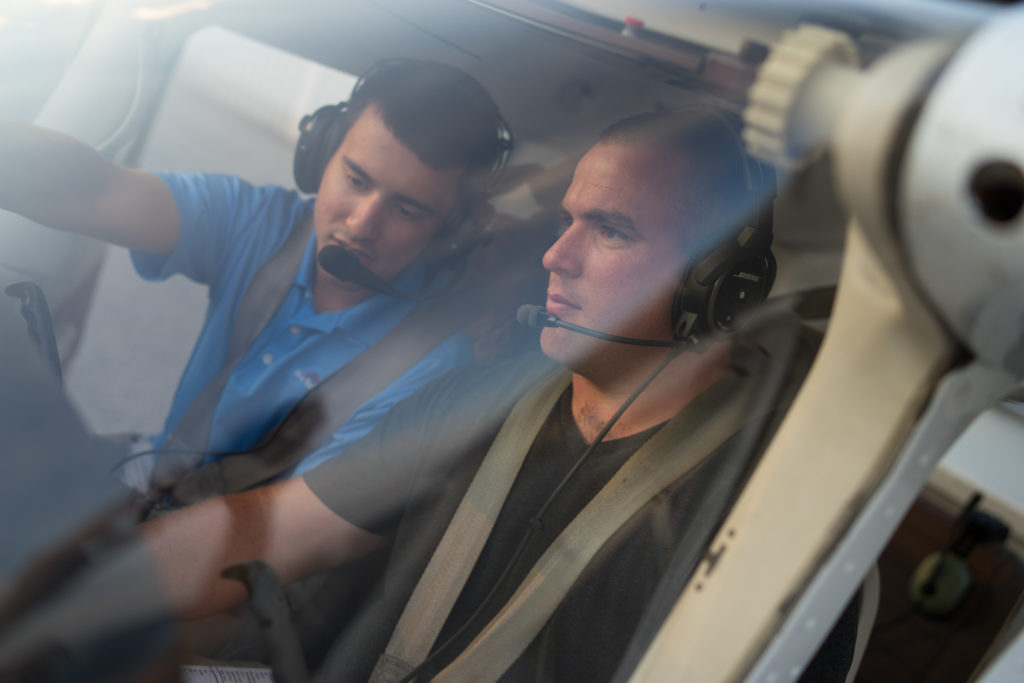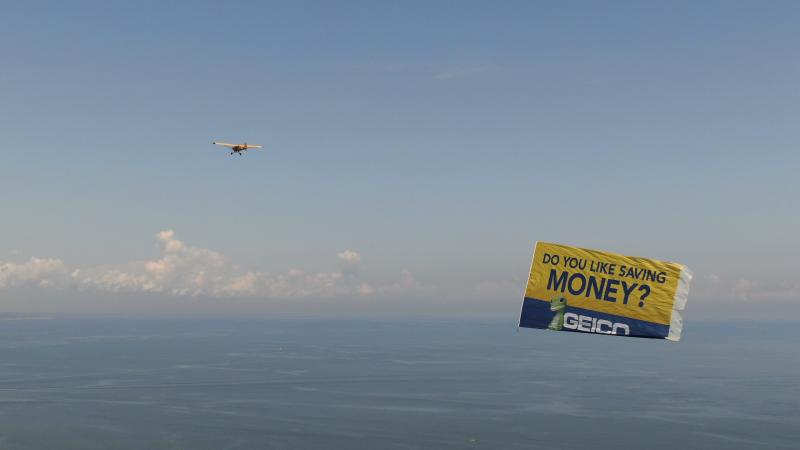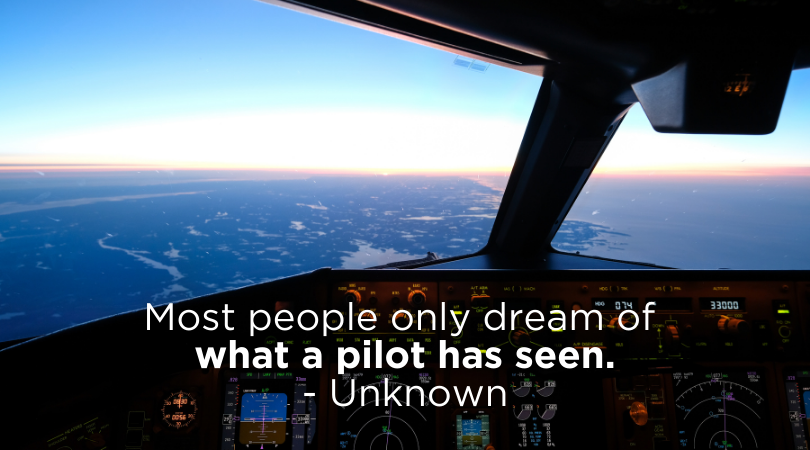Happy World Pilots’ Day! From recreational aviators to commercial airline pilots, we appreciate the dedicated women and men in the skies who safely transport billions of passengers and cargo each year to where they need to go. Anyone who chooses to pursue piloting an aircraft as a career knows it will require a lot of hard work and grit to master each step, plus continual training to keep their skills sharp. However, they also know the many benefits of having an office in the sky – getting paid to visit new cities, meeting new people, free travel benefits, and who can forget that amazing view from the cockpit.
One comment we often hear from pilots is they don’t feel like what they do is really “work.” They love aviation and the feeling of wonder they get while soaring through the skies never goes away. But if pilots really love what they do, why are airlines struggling with an unprecedented pilot shortage? Why aren’t more young people entering the workforce? I think one factor may be that aviation is somewhat mysterious to the general population. It’s hard to know where to even get started, and easy to believe the myth that flight training is too expensive and takes too much time to pursue. What better way to celebrate World Pilots’ Day than to talk to Sarah Grefe from Blue Ridge Aviation to learn how local and state programs can put this career within reach. You may be surprised by what she has to say!
What are your thoughts on the pilot shortage, and how is Blue Ridge Aviation helping to fill this need locally?
Several factors are at play here, but one is that early retirement for career pilots was offered and received during the COVID pandemic. This alone created a shortage of captains, and airlines are scrambling to fill those vacancies, creating a ripple effect, especially for regional airlines. Another reason for the shortage is that flight training is typically an out-of-pocket expense or one that requires a student to attend an expensive college or university. That’s not entirely true. Blue Ridge Aviation, based at SHD, has been serving the local demand for flight training and aircraft rentals since 2013. With higher demands for pilots, Blue Ridge Aviation has teamed up with Blue Ridge Community College, allowing future commercial pilots to receive alternative student loans at reasonable interest rates for their flight training. Local flight training can be half the cost of what larger universities charge. Travel Weekly states that flight training and time building can cost $200,000. We offer the same training at an estimated cost of $50,000. Staying local is the most affordable route to begin a piloting career.
Are there any financial resources or programs to help students with the cost?
Yes, there are quite a few! If you Google Flight Training Scholarships, you will find so many resources. Here are a few we recommend.
- The Virginia Space Grant Consortium is accepting applications right now (due May 13) and provides FREE virtual ground school courses to Virginia high school students. After completion, students can do hands-on training at their local flight school.
- The Pilot Pathways Program offers a FREE intensive flight academy during the summer for high school students. The deadline has passed for this year, but it’s something to keep in mind for the future.
- The Virginia Department of Aviation has a number of scholarship opportunities posted on their website, including grants for teachers planning a lesson involving aviation.
- The FAA has a great selection of national scholarships listed online from various organizations.
How long does it take to become a pilot for hire?
This can take as little or as long as you need. The estimated time to finish training and become a flight instructor with a flight school or find a job with another aviation company is 9-14 months, depending on your availability. We have had students take two years, and some take four years to get to their airline or corporate career, with lessons taken around their busy schedules. Either way, the demand is high, and a career as a pilot is within reach right here in the Shenandoah Valley.
 What does the flight training process look like?
What does the flight training process look like?
A typical schedule is three to four days a week of flight lessons and study time for each rating earned, but we will cater to students who can do more or fewer days a week. You will start with your private pilot rating, then move into your instrument rating and finish with the commercial rating. From here, we like to have our students become our flight instructors. This allows you to be paid to build flight hours up to the 1500 minimum hours needed to work for the airlines. Flight training is step-by-step process, and we can guide you through each one.
Can you share a few success stories of your former students and flight instructors?
Blue Ridge Aviation has sent several commercial pilots and flight instructors into the aviation workforce. Former students and flight instructors now work for private industries like Dynamic Aviation, Grant Aviation, and Eagle Aviation, to name a few. Local students to flight instructors are also now with regional airlines such as Republic Airlines, SkyWest, Mesa Airlines, and majors like United.
One of our very first BRCC students who became to flight instructor with us was hired on with SkyWest and made it as a captain within a year. Another great success story is someone who decided to make a career change from police officer to flight instructor. He went through BRCC for the ability to apply for alternative loans to cover flight training. He is now building time to apply to the airlines.
Why do they say it costs so much to be a pilot?
Because the estimated costs always include building time in the air at the student’s out-of-pocket expense. Becoming a flight instructor pays the instructor for their time in the plane while they are teaching students rather than the instructor paying for each hour that they build.
Boeing reports a need to hire 637,00 plots to keep up with demand by 2037. Airlines are increasing pay rates and offering larger signing bonuses to help obtain more interest in the career. Signing bonuses are a great way for pilots to pay off whatever may be left on their student loans.
 Do only flight instructors build enough time to go to the airlines?
Do only flight instructors build enough time to go to the airlines?
No, there are multiple options for time building. Locally, Dynamic Aviation offers positions for limited flight hour applicants. Banner towing at the beach is always an appealing option too. There are also skydive operations in the surrounding area that hire pilots as well. You can get creative with how you build your time.
Some people say that aviation career choices are limited; is that true?
Not true at all. In addition to the need for pilots, the aviation industry needs maintenance technicians, architecture and design staff, experts in avionics and engineering, operations, ground support, and the list goes on. Pilots are needed in the private sector as well as commercial services.
Do I need a bachelor’s degree to become a pilot?
Regional airlines do not always require a four-year degree. Early retirement for seasoned pilots drastically fueled the need for new pilots, and this requirement has been relaxed. Charter companies and contracted jobs do not necessarily require a degree. Get the ratings and the flight hours; that’s what is needed for the job. Pilots can then use their ratings to get college credit approved for certain college programs and have a head start on an in-person or online program.
We really appreciate Sarah taking the time to answer some common questions about flight training. SHD is incredibly fortunate to have a great flight school based at SHD and a local community college that has developed programs to train the next generation of aviation professionals. If this is a path you or a loved one are considering, we’re always glad to answer your questions or point you in the right direction!

